WHS and Wellbeing Project: Community Business Australia Analysis
VerifiedAdded on 2022/10/02
|11
|3076
|22
Project
AI Summary
This project analyzes the workplace diversity, Work Health and Safety (WHS), and well-being practices of two community-based organizations: Community Business Australia and Conservation Volunteers Australia. It examines their policies, procedures, and strategies for promoting diversity and inclusion, including the roles of team leaders and managers, the impact on interpersonal relationships and service delivery, and relevant legislation and codes of practice. The project identifies barriers to inclusion, such as communication and language differences, and explores the benefits of diversity, such as increased creativity and employee engagement. It also assesses the effectiveness of cross-cultural communication within these workplaces. The analysis covers various aspects of WHS, including physical, emotional, and ergonomic safety, as well as psychosocial hazards. The project highlights the importance of adhering to WHS laws and regulations and the implementation of safety and health policies to boost employee morale and productivity. The project also stresses the importance of effective consultation on health and safety within these organizations.
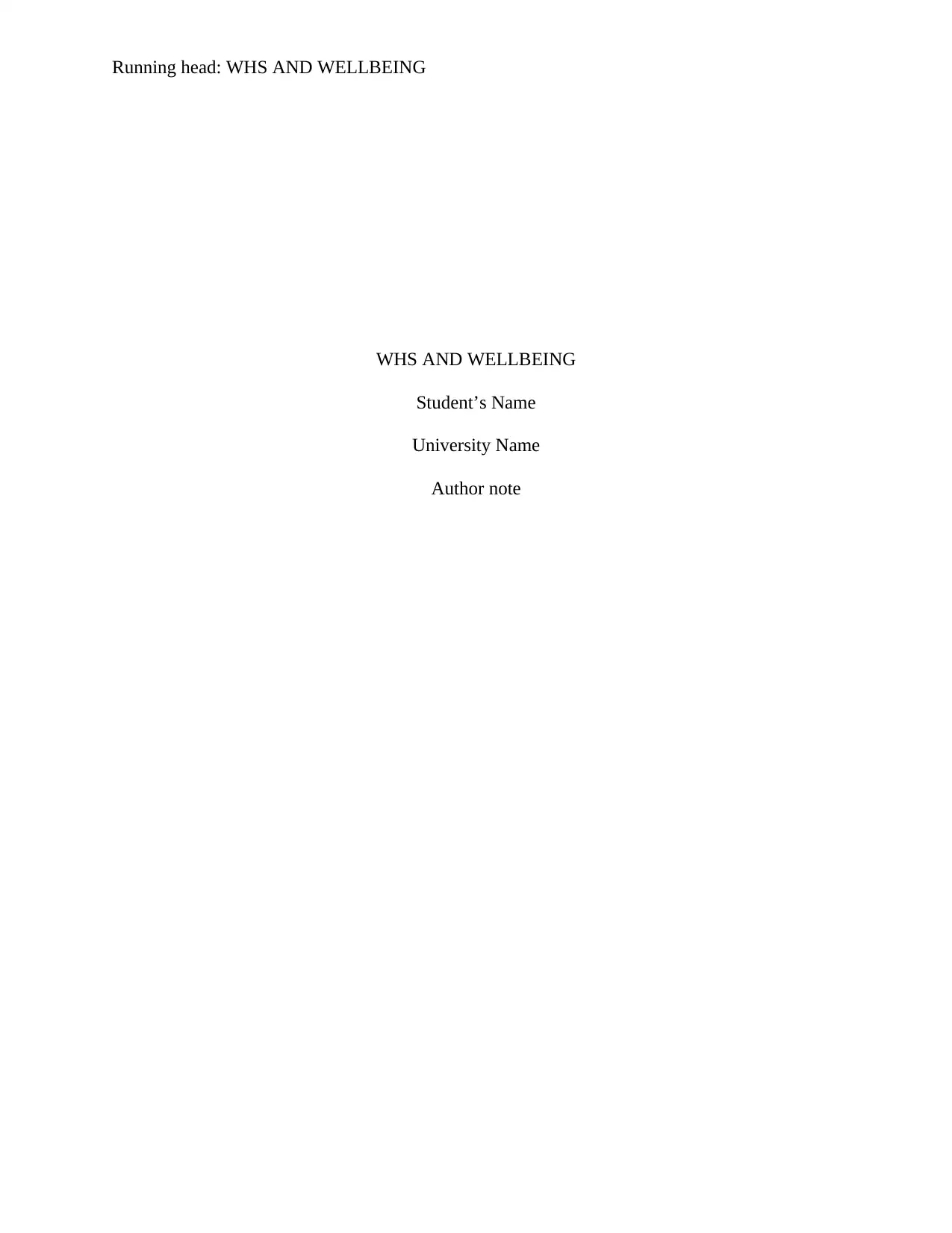
Running head: WHS AND WELLBEING
WHS AND WELLBEING
Student’s Name
University Name
Author note
WHS AND WELLBEING
Student’s Name
University Name
Author note
Paraphrase This Document
Need a fresh take? Get an instant paraphrase of this document with our AI Paraphraser

1
WHS AND WELLBEING
Project 1
Community Business Australia harnesses the power of business for driving social change.
The organization mainly focuses on building responsible leadership, tackling workplace
inequality, ensuring wellbeing and safety of the employees and promotion social inclusion in the
organization (Promoting Social Inclusion. 2019). The organization has informed and passionate
individuals who takes the initiative and the responsibility to leverage their position and influence
positive change in the organization. It undertakes leadership approach in tackling inequality at
workplace. By promoting inclusive and diversified workplace, it empowers all the staffs and the
employees to contribute their full potential to ensure long term success in the
organization(Promoting Social Inclusion. 2019). The organization undertakes proactive steps to
ensure safety and well being of the employees by providing them positive workplace culture. It
adapts strategies to empower the staffs and the employees in the organization. The organization
focuses on promoting social inclusion in the organization by aligning with the UN sustainable
development goals that is to “promote sustained, inclusive and sustainable economic growth, full
and productive employment and decent work for all” (Promoting Social Inclusion. 2019). The
organization has been successfully implementing the policies for workplace diversity and
inclusion.
As per research and analysis, it has been identified that Community Business Australia
strategically explores workplace issues and problems regarding diversity. However, the
organization initially focuses on Women employees (Barak, 2016). The organization has
undertaken range of initiatives and activities tailored to various individual circumstances. It is the
responsibility of the leaders and the managers of the organization to mainly focus on areas such
as meeting the needs and the requirements of the employees, up-skilling the staffs and the
WHS AND WELLBEING
Project 1
Community Business Australia harnesses the power of business for driving social change.
The organization mainly focuses on building responsible leadership, tackling workplace
inequality, ensuring wellbeing and safety of the employees and promotion social inclusion in the
organization (Promoting Social Inclusion. 2019). The organization has informed and passionate
individuals who takes the initiative and the responsibility to leverage their position and influence
positive change in the organization. It undertakes leadership approach in tackling inequality at
workplace. By promoting inclusive and diversified workplace, it empowers all the staffs and the
employees to contribute their full potential to ensure long term success in the
organization(Promoting Social Inclusion. 2019). The organization undertakes proactive steps to
ensure safety and well being of the employees by providing them positive workplace culture. It
adapts strategies to empower the staffs and the employees in the organization. The organization
focuses on promoting social inclusion in the organization by aligning with the UN sustainable
development goals that is to “promote sustained, inclusive and sustainable economic growth, full
and productive employment and decent work for all” (Promoting Social Inclusion. 2019). The
organization has been successfully implementing the policies for workplace diversity and
inclusion.
As per research and analysis, it has been identified that Community Business Australia
strategically explores workplace issues and problems regarding diversity. However, the
organization initially focuses on Women employees (Barak, 2016). The organization has
undertaken range of initiatives and activities tailored to various individual circumstances. It is the
responsibility of the leaders and the managers of the organization to mainly focus on areas such
as meeting the needs and the requirements of the employees, up-skilling the staffs and the
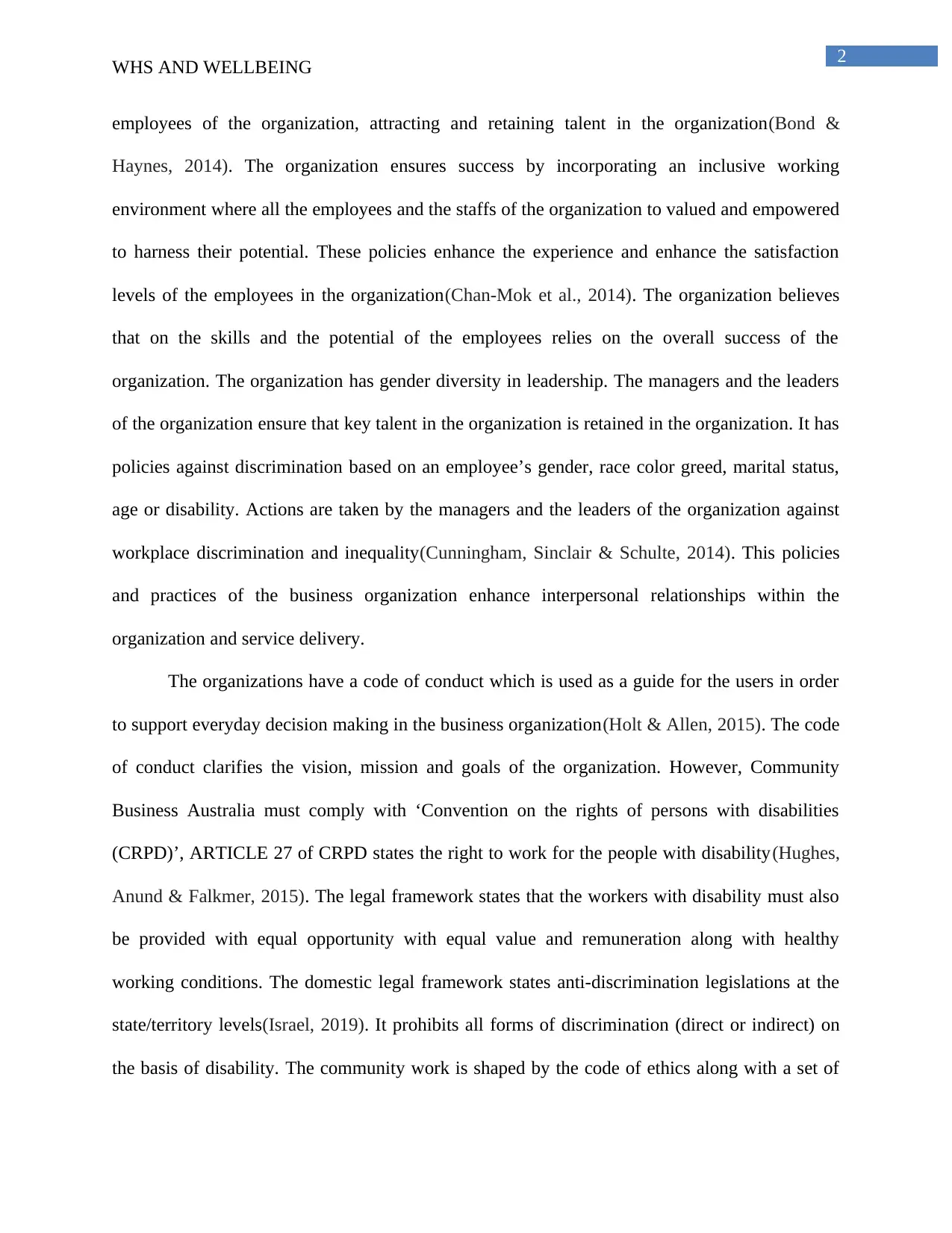
2
WHS AND WELLBEING
employees of the organization, attracting and retaining talent in the organization(Bond &
Haynes, 2014). The organization ensures success by incorporating an inclusive working
environment where all the employees and the staffs of the organization to valued and empowered
to harness their potential. These policies enhance the experience and enhance the satisfaction
levels of the employees in the organization(Chan-Mok et al., 2014). The organization believes
that on the skills and the potential of the employees relies on the overall success of the
organization. The organization has gender diversity in leadership. The managers and the leaders
of the organization ensure that key talent in the organization is retained in the organization. It has
policies against discrimination based on an employee’s gender, race color greed, marital status,
age or disability. Actions are taken by the managers and the leaders of the organization against
workplace discrimination and inequality(Cunningham, Sinclair & Schulte, 2014). This policies
and practices of the business organization enhance interpersonal relationships within the
organization and service delivery.
The organizations have a code of conduct which is used as a guide for the users in order
to support everyday decision making in the business organization(Holt & Allen, 2015). The code
of conduct clarifies the vision, mission and goals of the organization. However, Community
Business Australia must comply with ‘Convention on the rights of persons with disabilities
(CRPD)’, ARTICLE 27 of CRPD states the right to work for the people with disability(Hughes,
Anund & Falkmer, 2015). The legal framework states that the workers with disability must also
be provided with equal opportunity with equal value and remuneration along with healthy
working conditions. The domestic legal framework states anti-discrimination legislations at the
state/territory levels(Israel, 2019). It prohibits all forms of discrimination (direct or indirect) on
the basis of disability. The community work is shaped by the code of ethics along with a set of
WHS AND WELLBEING
employees of the organization, attracting and retaining talent in the organization(Bond &
Haynes, 2014). The organization ensures success by incorporating an inclusive working
environment where all the employees and the staffs of the organization to valued and empowered
to harness their potential. These policies enhance the experience and enhance the satisfaction
levels of the employees in the organization(Chan-Mok et al., 2014). The organization believes
that on the skills and the potential of the employees relies on the overall success of the
organization. The organization has gender diversity in leadership. The managers and the leaders
of the organization ensure that key talent in the organization is retained in the organization. It has
policies against discrimination based on an employee’s gender, race color greed, marital status,
age or disability. Actions are taken by the managers and the leaders of the organization against
workplace discrimination and inequality(Cunningham, Sinclair & Schulte, 2014). This policies
and practices of the business organization enhance interpersonal relationships within the
organization and service delivery.
The organizations have a code of conduct which is used as a guide for the users in order
to support everyday decision making in the business organization(Holt & Allen, 2015). The code
of conduct clarifies the vision, mission and goals of the organization. However, Community
Business Australia must comply with ‘Convention on the rights of persons with disabilities
(CRPD)’, ARTICLE 27 of CRPD states the right to work for the people with disability(Hughes,
Anund & Falkmer, 2015). The legal framework states that the workers with disability must also
be provided with equal opportunity with equal value and remuneration along with healthy
working conditions. The domestic legal framework states anti-discrimination legislations at the
state/territory levels(Israel, 2019). It prohibits all forms of discrimination (direct or indirect) on
the basis of disability. The community work is shaped by the code of ethics along with a set of
⊘ This is a preview!⊘
Do you want full access?
Subscribe today to unlock all pages.

Trusted by 1+ million students worldwide
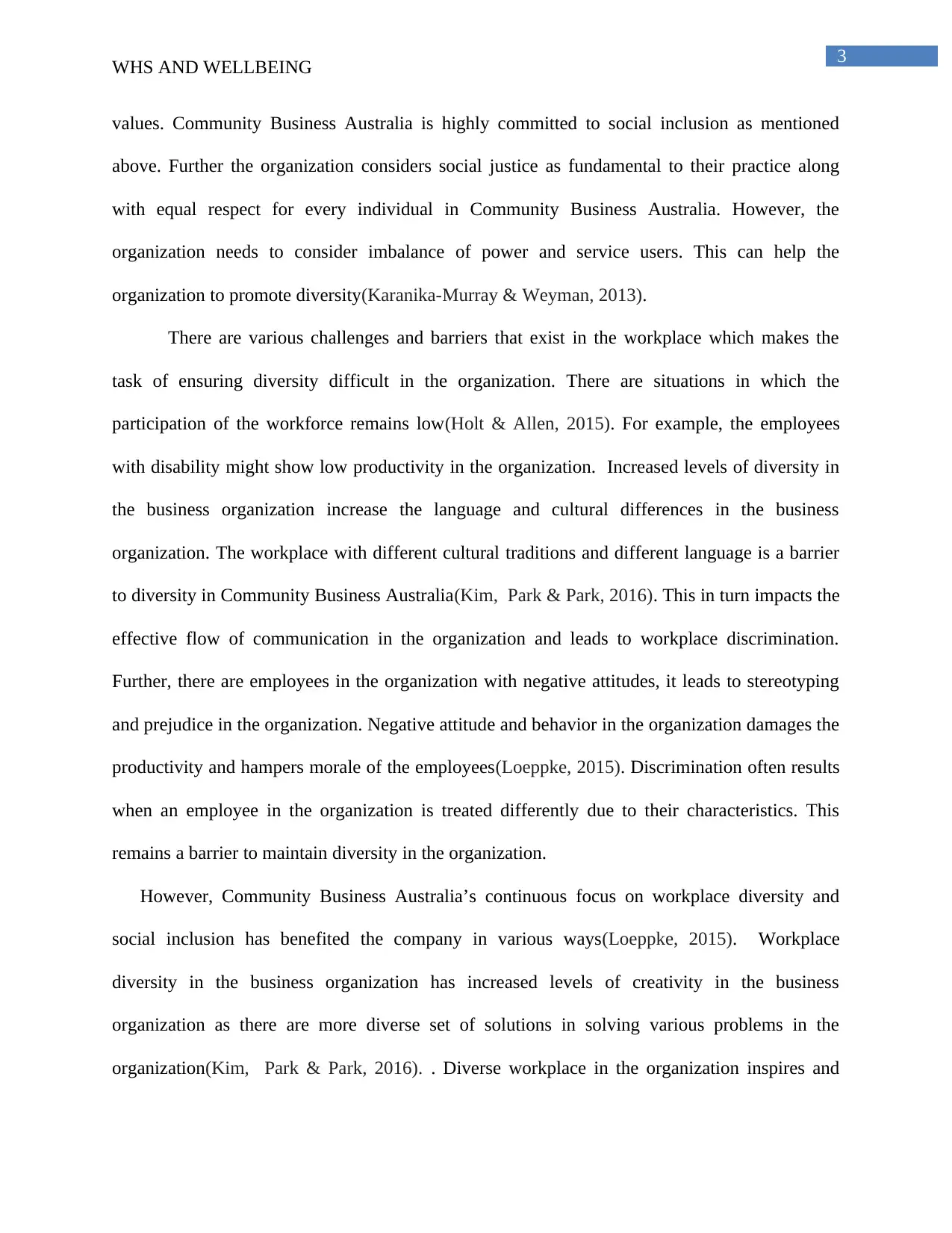
3
WHS AND WELLBEING
values. Community Business Australia is highly committed to social inclusion as mentioned
above. Further the organization considers social justice as fundamental to their practice along
with equal respect for every individual in Community Business Australia. However, the
organization needs to consider imbalance of power and service users. This can help the
organization to promote diversity(Karanika-Murray & Weyman, 2013).
There are various challenges and barriers that exist in the workplace which makes the
task of ensuring diversity difficult in the organization. There are situations in which the
participation of the workforce remains low(Holt & Allen, 2015). For example, the employees
with disability might show low productivity in the organization. Increased levels of diversity in
the business organization increase the language and cultural differences in the business
organization. The workplace with different cultural traditions and different language is a barrier
to diversity in Community Business Australia(Kim, Park & Park, 2016). This in turn impacts the
effective flow of communication in the organization and leads to workplace discrimination.
Further, there are employees in the organization with negative attitudes, it leads to stereotyping
and prejudice in the organization. Negative attitude and behavior in the organization damages the
productivity and hampers morale of the employees(Loeppke, 2015). Discrimination often results
when an employee in the organization is treated differently due to their characteristics. This
remains a barrier to maintain diversity in the organization.
However, Community Business Australia’s continuous focus on workplace diversity and
social inclusion has benefited the company in various ways(Loeppke, 2015). Workplace
diversity in the business organization has increased levels of creativity in the business
organization as there are more diverse set of solutions in solving various problems in the
organization(Kim, Park & Park, 2016). . Diverse workplace in the organization inspires and
WHS AND WELLBEING
values. Community Business Australia is highly committed to social inclusion as mentioned
above. Further the organization considers social justice as fundamental to their practice along
with equal respect for every individual in Community Business Australia. However, the
organization needs to consider imbalance of power and service users. This can help the
organization to promote diversity(Karanika-Murray & Weyman, 2013).
There are various challenges and barriers that exist in the workplace which makes the
task of ensuring diversity difficult in the organization. There are situations in which the
participation of the workforce remains low(Holt & Allen, 2015). For example, the employees
with disability might show low productivity in the organization. Increased levels of diversity in
the business organization increase the language and cultural differences in the business
organization. The workplace with different cultural traditions and different language is a barrier
to diversity in Community Business Australia(Kim, Park & Park, 2016). This in turn impacts the
effective flow of communication in the organization and leads to workplace discrimination.
Further, there are employees in the organization with negative attitudes, it leads to stereotyping
and prejudice in the organization. Negative attitude and behavior in the organization damages the
productivity and hampers morale of the employees(Loeppke, 2015). Discrimination often results
when an employee in the organization is treated differently due to their characteristics. This
remains a barrier to maintain diversity in the organization.
However, Community Business Australia’s continuous focus on workplace diversity and
social inclusion has benefited the company in various ways(Loeppke, 2015). Workplace
diversity in the business organization has increased levels of creativity in the business
organization as there are more diverse set of solutions in solving various problems in the
organization(Kim, Park & Park, 2016). . Diverse workplace in the organization inspires and
Paraphrase This Document
Need a fresh take? Get an instant paraphrase of this document with our AI Paraphraser
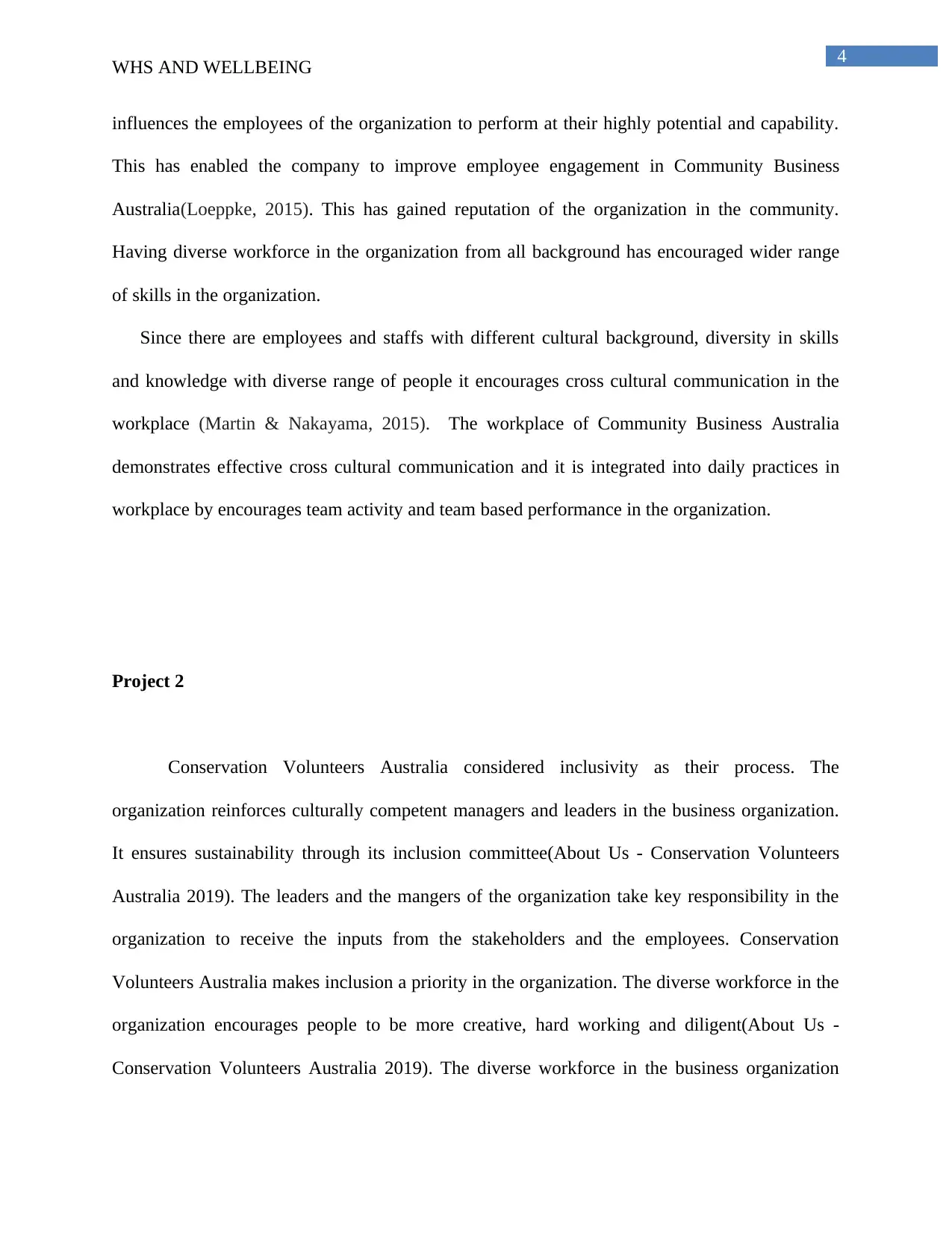
4
WHS AND WELLBEING
influences the employees of the organization to perform at their highly potential and capability.
This has enabled the company to improve employee engagement in Community Business
Australia(Loeppke, 2015). This has gained reputation of the organization in the community.
Having diverse workforce in the organization from all background has encouraged wider range
of skills in the organization.
Since there are employees and staffs with different cultural background, diversity in skills
and knowledge with diverse range of people it encourages cross cultural communication in the
workplace (Martin & Nakayama, 2015). The workplace of Community Business Australia
demonstrates effective cross cultural communication and it is integrated into daily practices in
workplace by encourages team activity and team based performance in the organization.
Project 2
Conservation Volunteers Australia considered inclusivity as their process. The
organization reinforces culturally competent managers and leaders in the business organization.
It ensures sustainability through its inclusion committee(About Us - Conservation Volunteers
Australia 2019). The leaders and the mangers of the organization take key responsibility in the
organization to receive the inputs from the stakeholders and the employees. Conservation
Volunteers Australia makes inclusion a priority in the organization. The diverse workforce in the
organization encourages people to be more creative, hard working and diligent(About Us -
Conservation Volunteers Australia 2019). The diverse workforce in the business organization
WHS AND WELLBEING
influences the employees of the organization to perform at their highly potential and capability.
This has enabled the company to improve employee engagement in Community Business
Australia(Loeppke, 2015). This has gained reputation of the organization in the community.
Having diverse workforce in the organization from all background has encouraged wider range
of skills in the organization.
Since there are employees and staffs with different cultural background, diversity in skills
and knowledge with diverse range of people it encourages cross cultural communication in the
workplace (Martin & Nakayama, 2015). The workplace of Community Business Australia
demonstrates effective cross cultural communication and it is integrated into daily practices in
workplace by encourages team activity and team based performance in the organization.
Project 2
Conservation Volunteers Australia considered inclusivity as their process. The
organization reinforces culturally competent managers and leaders in the business organization.
It ensures sustainability through its inclusion committee(About Us - Conservation Volunteers
Australia 2019). The leaders and the mangers of the organization take key responsibility in the
organization to receive the inputs from the stakeholders and the employees. Conservation
Volunteers Australia makes inclusion a priority in the organization. The diverse workforce in the
organization encourages people to be more creative, hard working and diligent(About Us -
Conservation Volunteers Australia 2019). The diverse workforce in the business organization
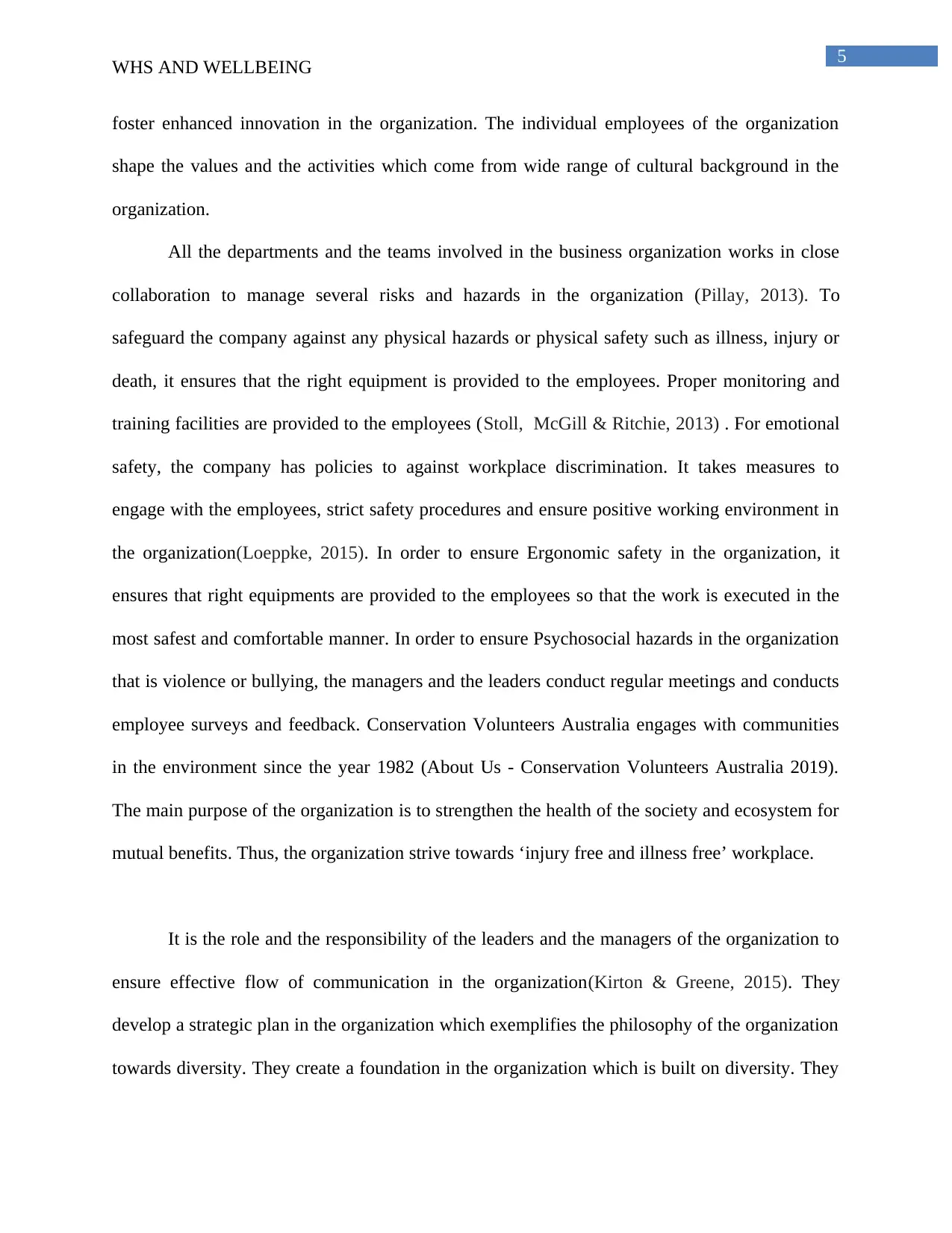
5
WHS AND WELLBEING
foster enhanced innovation in the organization. The individual employees of the organization
shape the values and the activities which come from wide range of cultural background in the
organization.
All the departments and the teams involved in the business organization works in close
collaboration to manage several risks and hazards in the organization (Pillay, 2013). To
safeguard the company against any physical hazards or physical safety such as illness, injury or
death, it ensures that the right equipment is provided to the employees. Proper monitoring and
training facilities are provided to the employees (Stoll, McGill & Ritchie, 2013) . For emotional
safety, the company has policies to against workplace discrimination. It takes measures to
engage with the employees, strict safety procedures and ensure positive working environment in
the organization(Loeppke, 2015). In order to ensure Ergonomic safety in the organization, it
ensures that right equipments are provided to the employees so that the work is executed in the
most safest and comfortable manner. In order to ensure Psychosocial hazards in the organization
that is violence or bullying, the managers and the leaders conduct regular meetings and conducts
employee surveys and feedback. Conservation Volunteers Australia engages with communities
in the environment since the year 1982 (About Us - Conservation Volunteers Australia 2019).
The main purpose of the organization is to strengthen the health of the society and ecosystem for
mutual benefits. Thus, the organization strive towards ‘injury free and illness free’ workplace.
It is the role and the responsibility of the leaders and the managers of the organization to
ensure effective flow of communication in the organization(Kirton & Greene, 2015). They
develop a strategic plan in the organization which exemplifies the philosophy of the organization
towards diversity. They create a foundation in the organization which is built on diversity. They
WHS AND WELLBEING
foster enhanced innovation in the organization. The individual employees of the organization
shape the values and the activities which come from wide range of cultural background in the
organization.
All the departments and the teams involved in the business organization works in close
collaboration to manage several risks and hazards in the organization (Pillay, 2013). To
safeguard the company against any physical hazards or physical safety such as illness, injury or
death, it ensures that the right equipment is provided to the employees. Proper monitoring and
training facilities are provided to the employees (Stoll, McGill & Ritchie, 2013) . For emotional
safety, the company has policies to against workplace discrimination. It takes measures to
engage with the employees, strict safety procedures and ensure positive working environment in
the organization(Loeppke, 2015). In order to ensure Ergonomic safety in the organization, it
ensures that right equipments are provided to the employees so that the work is executed in the
most safest and comfortable manner. In order to ensure Psychosocial hazards in the organization
that is violence or bullying, the managers and the leaders conduct regular meetings and conducts
employee surveys and feedback. Conservation Volunteers Australia engages with communities
in the environment since the year 1982 (About Us - Conservation Volunteers Australia 2019).
The main purpose of the organization is to strengthen the health of the society and ecosystem for
mutual benefits. Thus, the organization strive towards ‘injury free and illness free’ workplace.
It is the role and the responsibility of the leaders and the managers of the organization to
ensure effective flow of communication in the organization(Kirton & Greene, 2015). They
develop a strategic plan in the organization which exemplifies the philosophy of the organization
towards diversity. They create a foundation in the organization which is built on diversity. They
⊘ This is a preview!⊘
Do you want full access?
Subscribe today to unlock all pages.

Trusted by 1+ million students worldwide
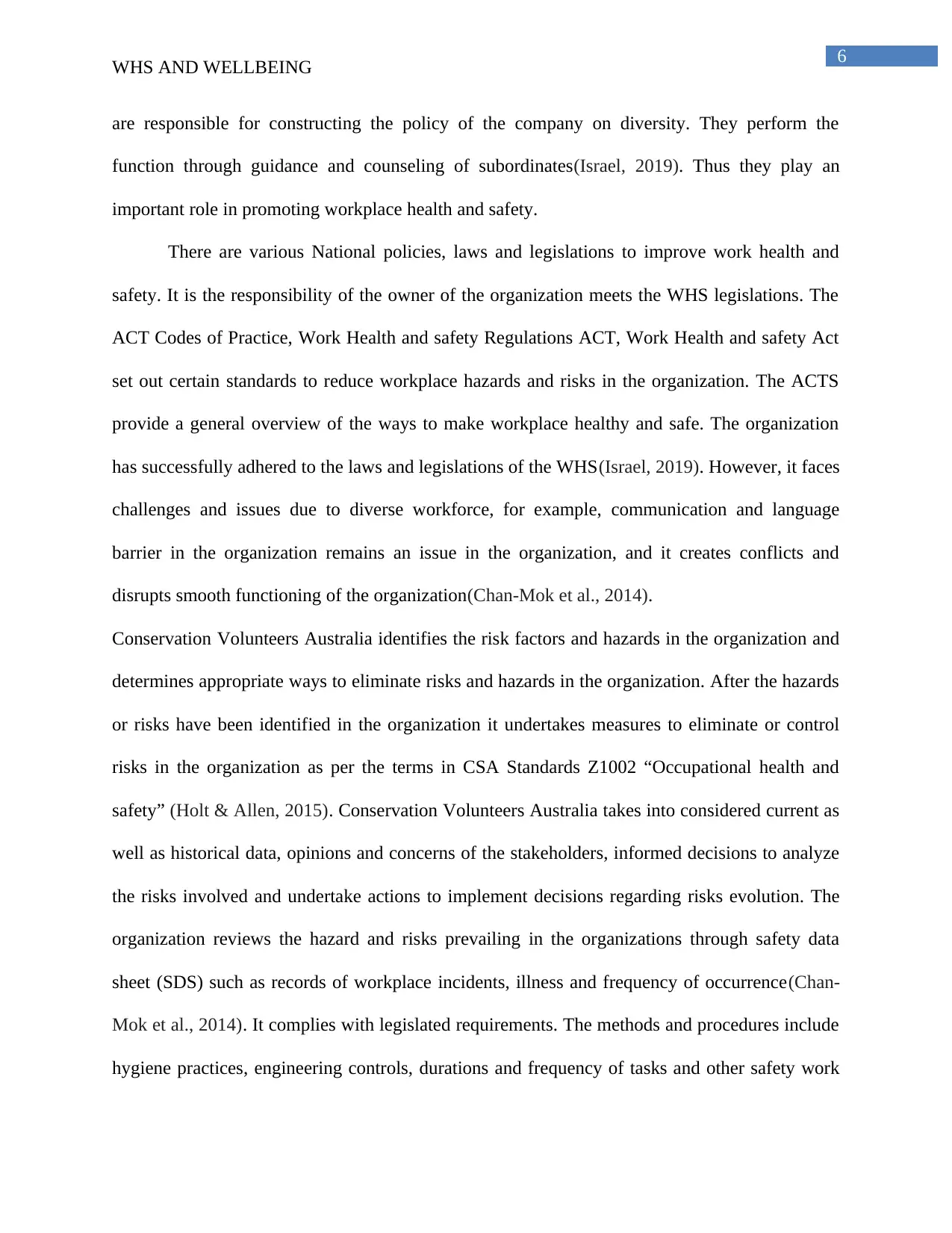
6
WHS AND WELLBEING
are responsible for constructing the policy of the company on diversity. They perform the
function through guidance and counseling of subordinates(Israel, 2019). Thus they play an
important role in promoting workplace health and safety.
There are various National policies, laws and legislations to improve work health and
safety. It is the responsibility of the owner of the organization meets the WHS legislations. The
ACT Codes of Practice, Work Health and safety Regulations ACT, Work Health and safety Act
set out certain standards to reduce workplace hazards and risks in the organization. The ACTS
provide a general overview of the ways to make workplace healthy and safe. The organization
has successfully adhered to the laws and legislations of the WHS(Israel, 2019). However, it faces
challenges and issues due to diverse workforce, for example, communication and language
barrier in the organization remains an issue in the organization, and it creates conflicts and
disrupts smooth functioning of the organization(Chan-Mok et al., 2014).
Conservation Volunteers Australia identifies the risk factors and hazards in the organization and
determines appropriate ways to eliminate risks and hazards in the organization. After the hazards
or risks have been identified in the organization it undertakes measures to eliminate or control
risks in the organization as per the terms in CSA Standards Z1002 “Occupational health and
safety” (Holt & Allen, 2015). Conservation Volunteers Australia takes into considered current as
well as historical data, opinions and concerns of the stakeholders, informed decisions to analyze
the risks involved and undertake actions to implement decisions regarding risks evolution. The
organization reviews the hazard and risks prevailing in the organizations through safety data
sheet (SDS) such as records of workplace incidents, illness and frequency of occurrence(Chan-
Mok et al., 2014). It complies with legislated requirements. The methods and procedures include
hygiene practices, engineering controls, durations and frequency of tasks and other safety work
WHS AND WELLBEING
are responsible for constructing the policy of the company on diversity. They perform the
function through guidance and counseling of subordinates(Israel, 2019). Thus they play an
important role in promoting workplace health and safety.
There are various National policies, laws and legislations to improve work health and
safety. It is the responsibility of the owner of the organization meets the WHS legislations. The
ACT Codes of Practice, Work Health and safety Regulations ACT, Work Health and safety Act
set out certain standards to reduce workplace hazards and risks in the organization. The ACTS
provide a general overview of the ways to make workplace healthy and safe. The organization
has successfully adhered to the laws and legislations of the WHS(Israel, 2019). However, it faces
challenges and issues due to diverse workforce, for example, communication and language
barrier in the organization remains an issue in the organization, and it creates conflicts and
disrupts smooth functioning of the organization(Chan-Mok et al., 2014).
Conservation Volunteers Australia identifies the risk factors and hazards in the organization and
determines appropriate ways to eliminate risks and hazards in the organization. After the hazards
or risks have been identified in the organization it undertakes measures to eliminate or control
risks in the organization as per the terms in CSA Standards Z1002 “Occupational health and
safety” (Holt & Allen, 2015). Conservation Volunteers Australia takes into considered current as
well as historical data, opinions and concerns of the stakeholders, informed decisions to analyze
the risks involved and undertake actions to implement decisions regarding risks evolution. The
organization reviews the hazard and risks prevailing in the organizations through safety data
sheet (SDS) such as records of workplace incidents, illness and frequency of occurrence(Chan-
Mok et al., 2014). It complies with legislated requirements. The methods and procedures include
hygiene practices, engineering controls, durations and frequency of tasks and other safety work
Paraphrase This Document
Need a fresh take? Get an instant paraphrase of this document with our AI Paraphraser
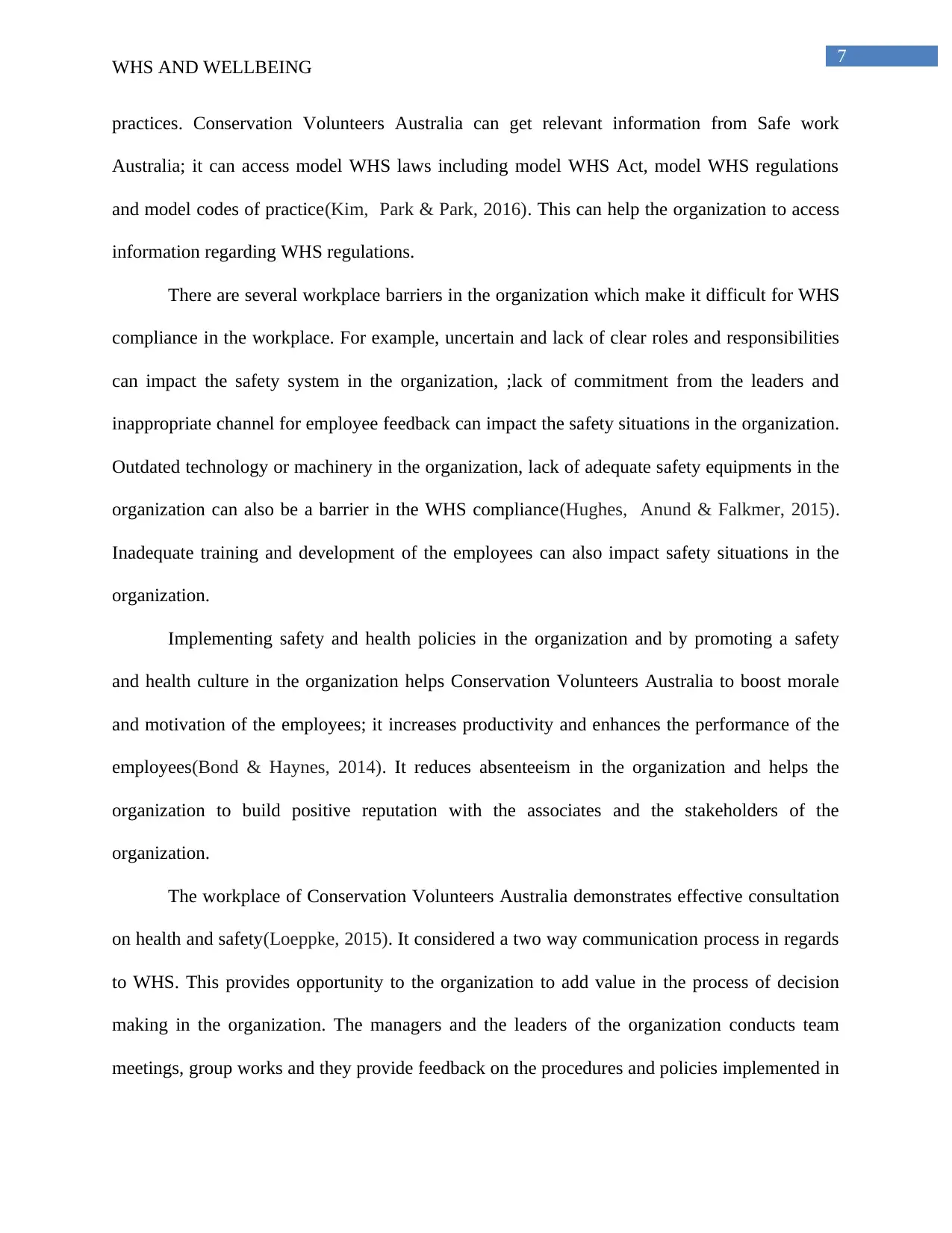
7
WHS AND WELLBEING
practices. Conservation Volunteers Australia can get relevant information from Safe work
Australia; it can access model WHS laws including model WHS Act, model WHS regulations
and model codes of practice(Kim, Park & Park, 2016). This can help the organization to access
information regarding WHS regulations.
There are several workplace barriers in the organization which make it difficult for WHS
compliance in the workplace. For example, uncertain and lack of clear roles and responsibilities
can impact the safety system in the organization, ;lack of commitment from the leaders and
inappropriate channel for employee feedback can impact the safety situations in the organization.
Outdated technology or machinery in the organization, lack of adequate safety equipments in the
organization can also be a barrier in the WHS compliance(Hughes, Anund & Falkmer, 2015).
Inadequate training and development of the employees can also impact safety situations in the
organization.
Implementing safety and health policies in the organization and by promoting a safety
and health culture in the organization helps Conservation Volunteers Australia to boost morale
and motivation of the employees; it increases productivity and enhances the performance of the
employees(Bond & Haynes, 2014). It reduces absenteeism in the organization and helps the
organization to build positive reputation with the associates and the stakeholders of the
organization.
The workplace of Conservation Volunteers Australia demonstrates effective consultation
on health and safety(Loeppke, 2015). It considered a two way communication process in regards
to WHS. This provides opportunity to the organization to add value in the process of decision
making in the organization. The managers and the leaders of the organization conducts team
meetings, group works and they provide feedback on the procedures and policies implemented in
WHS AND WELLBEING
practices. Conservation Volunteers Australia can get relevant information from Safe work
Australia; it can access model WHS laws including model WHS Act, model WHS regulations
and model codes of practice(Kim, Park & Park, 2016). This can help the organization to access
information regarding WHS regulations.
There are several workplace barriers in the organization which make it difficult for WHS
compliance in the workplace. For example, uncertain and lack of clear roles and responsibilities
can impact the safety system in the organization, ;lack of commitment from the leaders and
inappropriate channel for employee feedback can impact the safety situations in the organization.
Outdated technology or machinery in the organization, lack of adequate safety equipments in the
organization can also be a barrier in the WHS compliance(Hughes, Anund & Falkmer, 2015).
Inadequate training and development of the employees can also impact safety situations in the
organization.
Implementing safety and health policies in the organization and by promoting a safety
and health culture in the organization helps Conservation Volunteers Australia to boost morale
and motivation of the employees; it increases productivity and enhances the performance of the
employees(Bond & Haynes, 2014). It reduces absenteeism in the organization and helps the
organization to build positive reputation with the associates and the stakeholders of the
organization.
The workplace of Conservation Volunteers Australia demonstrates effective consultation
on health and safety(Loeppke, 2015). It considered a two way communication process in regards
to WHS. This provides opportunity to the organization to add value in the process of decision
making in the organization. The managers and the leaders of the organization conducts team
meetings, group works and they provide feedback on the procedures and policies implemented in
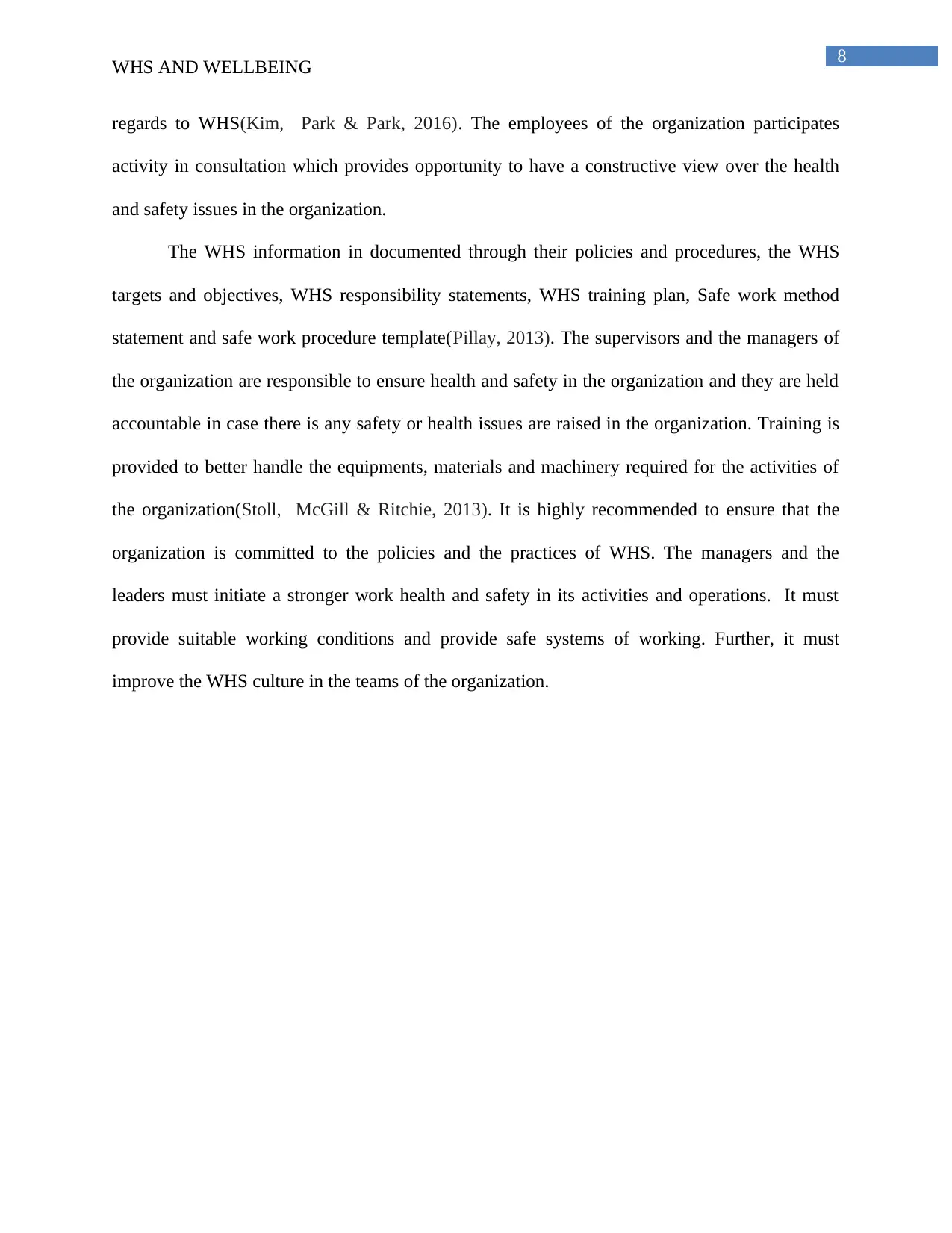
8
WHS AND WELLBEING
regards to WHS(Kim, Park & Park, 2016). The employees of the organization participates
activity in consultation which provides opportunity to have a constructive view over the health
and safety issues in the organization.
The WHS information in documented through their policies and procedures, the WHS
targets and objectives, WHS responsibility statements, WHS training plan, Safe work method
statement and safe work procedure template(Pillay, 2013). The supervisors and the managers of
the organization are responsible to ensure health and safety in the organization and they are held
accountable in case there is any safety or health issues are raised in the organization. Training is
provided to better handle the equipments, materials and machinery required for the activities of
the organization(Stoll, McGill & Ritchie, 2013). It is highly recommended to ensure that the
organization is committed to the policies and the practices of WHS. The managers and the
leaders must initiate a stronger work health and safety in its activities and operations. It must
provide suitable working conditions and provide safe systems of working. Further, it must
improve the WHS culture in the teams of the organization.
WHS AND WELLBEING
regards to WHS(Kim, Park & Park, 2016). The employees of the organization participates
activity in consultation which provides opportunity to have a constructive view over the health
and safety issues in the organization.
The WHS information in documented through their policies and procedures, the WHS
targets and objectives, WHS responsibility statements, WHS training plan, Safe work method
statement and safe work procedure template(Pillay, 2013). The supervisors and the managers of
the organization are responsible to ensure health and safety in the organization and they are held
accountable in case there is any safety or health issues are raised in the organization. Training is
provided to better handle the equipments, materials and machinery required for the activities of
the organization(Stoll, McGill & Ritchie, 2013). It is highly recommended to ensure that the
organization is committed to the policies and the practices of WHS. The managers and the
leaders must initiate a stronger work health and safety in its activities and operations. It must
provide suitable working conditions and provide safe systems of working. Further, it must
improve the WHS culture in the teams of the organization.
⊘ This is a preview!⊘
Do you want full access?
Subscribe today to unlock all pages.

Trusted by 1+ million students worldwide
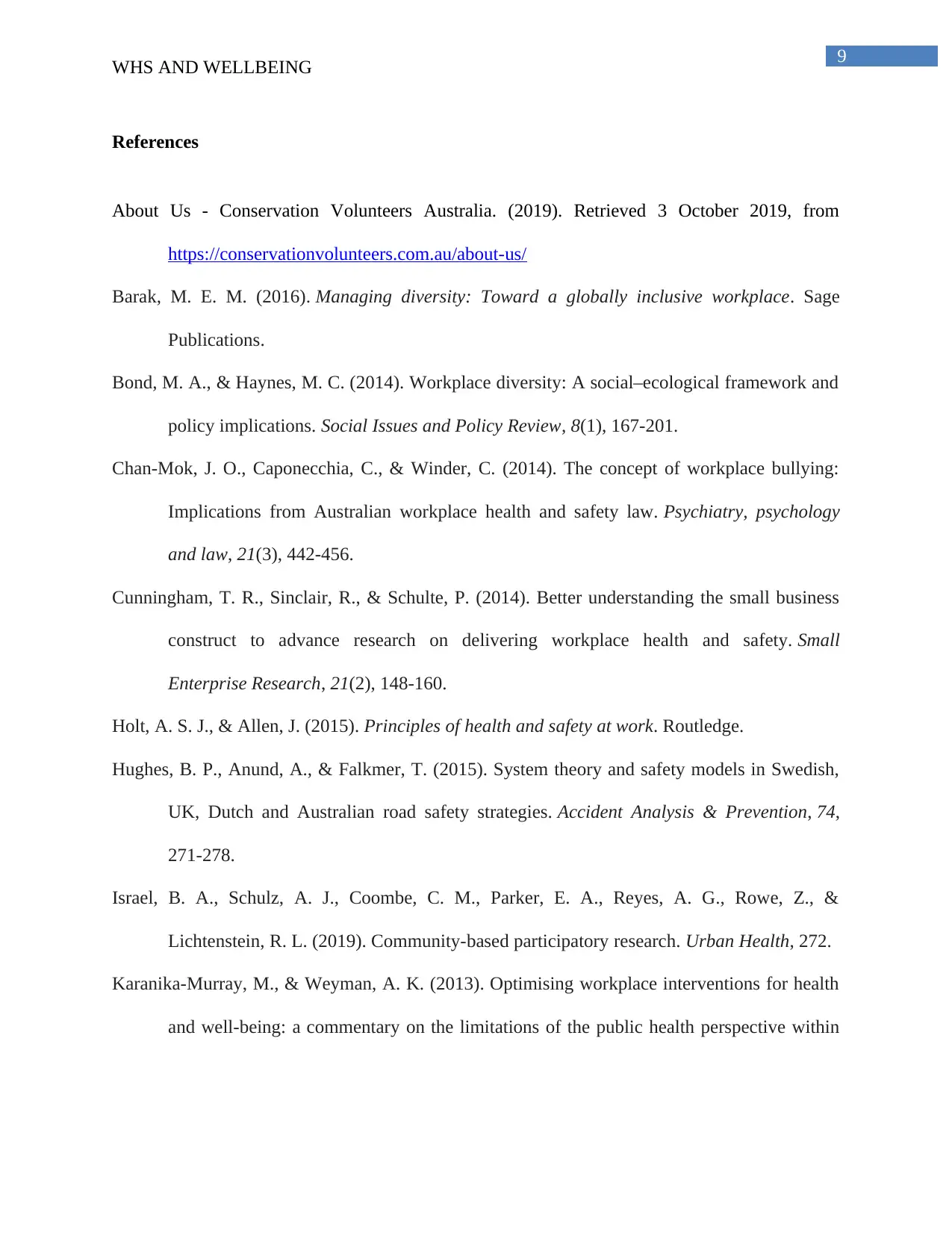
9
WHS AND WELLBEING
References
About Us - Conservation Volunteers Australia. (2019). Retrieved 3 October 2019, from
https://conservationvolunteers.com.au/about-us/
Barak, M. E. M. (2016). Managing diversity: Toward a globally inclusive workplace. Sage
Publications.
Bond, M. A., & Haynes, M. C. (2014). Workplace diversity: A social–ecological framework and
policy implications. Social Issues and Policy Review, 8(1), 167-201.
Chan-Mok, J. O., Caponecchia, C., & Winder, C. (2014). The concept of workplace bullying:
Implications from Australian workplace health and safety law. Psychiatry, psychology
and law, 21(3), 442-456.
Cunningham, T. R., Sinclair, R., & Schulte, P. (2014). Better understanding the small business
construct to advance research on delivering workplace health and safety. Small
Enterprise Research, 21(2), 148-160.
Holt, A. S. J., & Allen, J. (2015). Principles of health and safety at work. Routledge.
Hughes, B. P., Anund, A., & Falkmer, T. (2015). System theory and safety models in Swedish,
UK, Dutch and Australian road safety strategies. Accident Analysis & Prevention, 74,
271-278.
Israel, B. A., Schulz, A. J., Coombe, C. M., Parker, E. A., Reyes, A. G., Rowe, Z., &
Lichtenstein, R. L. (2019). Community-based participatory research. Urban Health, 272.
Karanika-Murray, M., & Weyman, A. K. (2013). Optimising workplace interventions for health
and well-being: a commentary on the limitations of the public health perspective within
WHS AND WELLBEING
References
About Us - Conservation Volunteers Australia. (2019). Retrieved 3 October 2019, from
https://conservationvolunteers.com.au/about-us/
Barak, M. E. M. (2016). Managing diversity: Toward a globally inclusive workplace. Sage
Publications.
Bond, M. A., & Haynes, M. C. (2014). Workplace diversity: A social–ecological framework and
policy implications. Social Issues and Policy Review, 8(1), 167-201.
Chan-Mok, J. O., Caponecchia, C., & Winder, C. (2014). The concept of workplace bullying:
Implications from Australian workplace health and safety law. Psychiatry, psychology
and law, 21(3), 442-456.
Cunningham, T. R., Sinclair, R., & Schulte, P. (2014). Better understanding the small business
construct to advance research on delivering workplace health and safety. Small
Enterprise Research, 21(2), 148-160.
Holt, A. S. J., & Allen, J. (2015). Principles of health and safety at work. Routledge.
Hughes, B. P., Anund, A., & Falkmer, T. (2015). System theory and safety models in Swedish,
UK, Dutch and Australian road safety strategies. Accident Analysis & Prevention, 74,
271-278.
Israel, B. A., Schulz, A. J., Coombe, C. M., Parker, E. A., Reyes, A. G., Rowe, Z., &
Lichtenstein, R. L. (2019). Community-based participatory research. Urban Health, 272.
Karanika-Murray, M., & Weyman, A. K. (2013). Optimising workplace interventions for health
and well-being: a commentary on the limitations of the public health perspective within
Paraphrase This Document
Need a fresh take? Get an instant paraphrase of this document with our AI Paraphraser
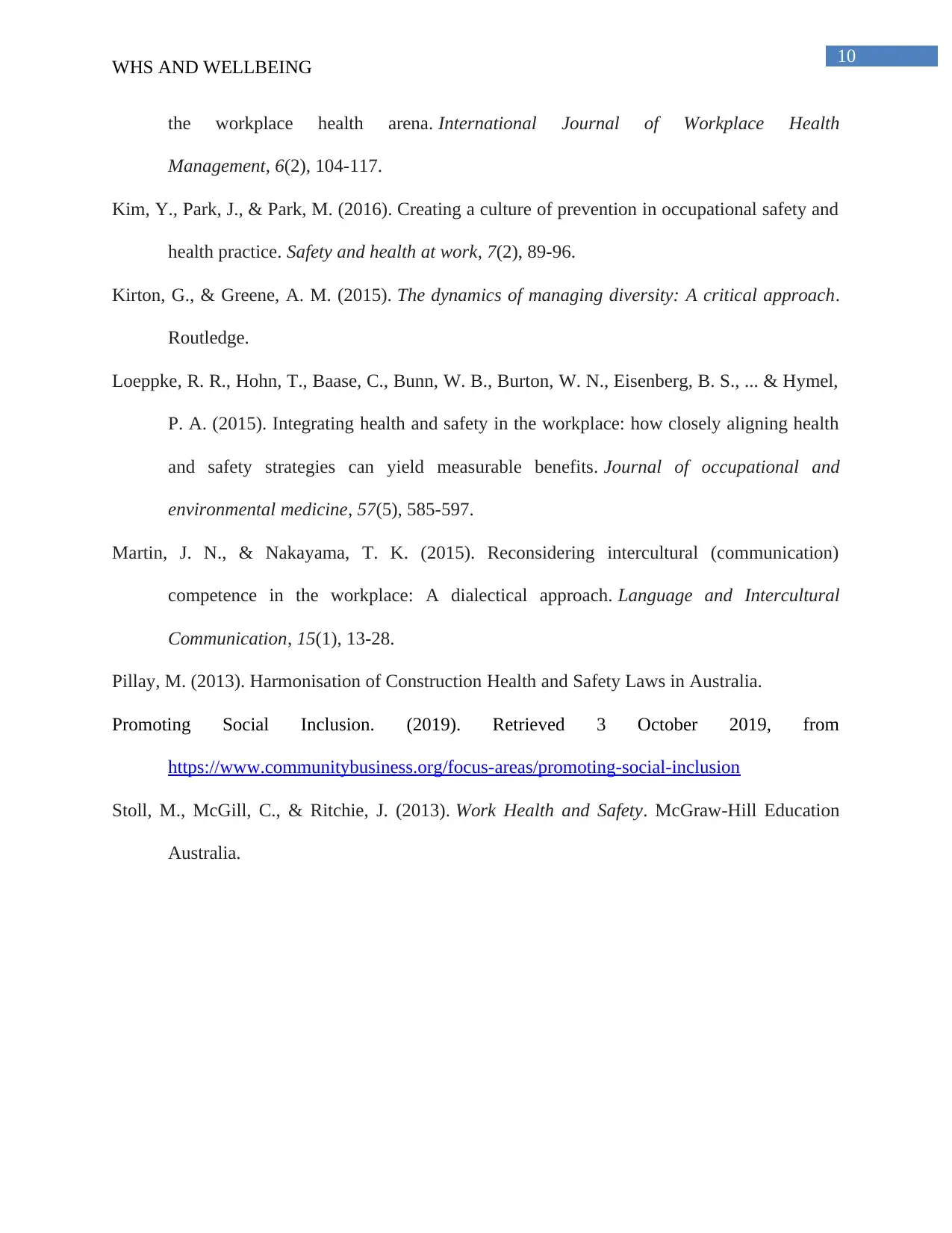
10
WHS AND WELLBEING
the workplace health arena. International Journal of Workplace Health
Management, 6(2), 104-117.
Kim, Y., Park, J., & Park, M. (2016). Creating a culture of prevention in occupational safety and
health practice. Safety and health at work, 7(2), 89-96.
Kirton, G., & Greene, A. M. (2015). The dynamics of managing diversity: A critical approach.
Routledge.
Loeppke, R. R., Hohn, T., Baase, C., Bunn, W. B., Burton, W. N., Eisenberg, B. S., ... & Hymel,
P. A. (2015). Integrating health and safety in the workplace: how closely aligning health
and safety strategies can yield measurable benefits. Journal of occupational and
environmental medicine, 57(5), 585-597.
Martin, J. N., & Nakayama, T. K. (2015). Reconsidering intercultural (communication)
competence in the workplace: A dialectical approach. Language and Intercultural
Communication, 15(1), 13-28.
Pillay, M. (2013). Harmonisation of Construction Health and Safety Laws in Australia.
Promoting Social Inclusion. (2019). Retrieved 3 October 2019, from
https://www.communitybusiness.org/focus-areas/promoting-social-inclusion
Stoll, M., McGill, C., & Ritchie, J. (2013). Work Health and Safety. McGraw-Hill Education
Australia.
WHS AND WELLBEING
the workplace health arena. International Journal of Workplace Health
Management, 6(2), 104-117.
Kim, Y., Park, J., & Park, M. (2016). Creating a culture of prevention in occupational safety and
health practice. Safety and health at work, 7(2), 89-96.
Kirton, G., & Greene, A. M. (2015). The dynamics of managing diversity: A critical approach.
Routledge.
Loeppke, R. R., Hohn, T., Baase, C., Bunn, W. B., Burton, W. N., Eisenberg, B. S., ... & Hymel,
P. A. (2015). Integrating health and safety in the workplace: how closely aligning health
and safety strategies can yield measurable benefits. Journal of occupational and
environmental medicine, 57(5), 585-597.
Martin, J. N., & Nakayama, T. K. (2015). Reconsidering intercultural (communication)
competence in the workplace: A dialectical approach. Language and Intercultural
Communication, 15(1), 13-28.
Pillay, M. (2013). Harmonisation of Construction Health and Safety Laws in Australia.
Promoting Social Inclusion. (2019). Retrieved 3 October 2019, from
https://www.communitybusiness.org/focus-areas/promoting-social-inclusion
Stoll, M., McGill, C., & Ritchie, J. (2013). Work Health and Safety. McGraw-Hill Education
Australia.
1 out of 11
Related Documents
Your All-in-One AI-Powered Toolkit for Academic Success.
+13062052269
info@desklib.com
Available 24*7 on WhatsApp / Email
![[object Object]](/_next/static/media/star-bottom.7253800d.svg)
Unlock your academic potential
Copyright © 2020–2025 A2Z Services. All Rights Reserved. Developed and managed by ZUCOL.





